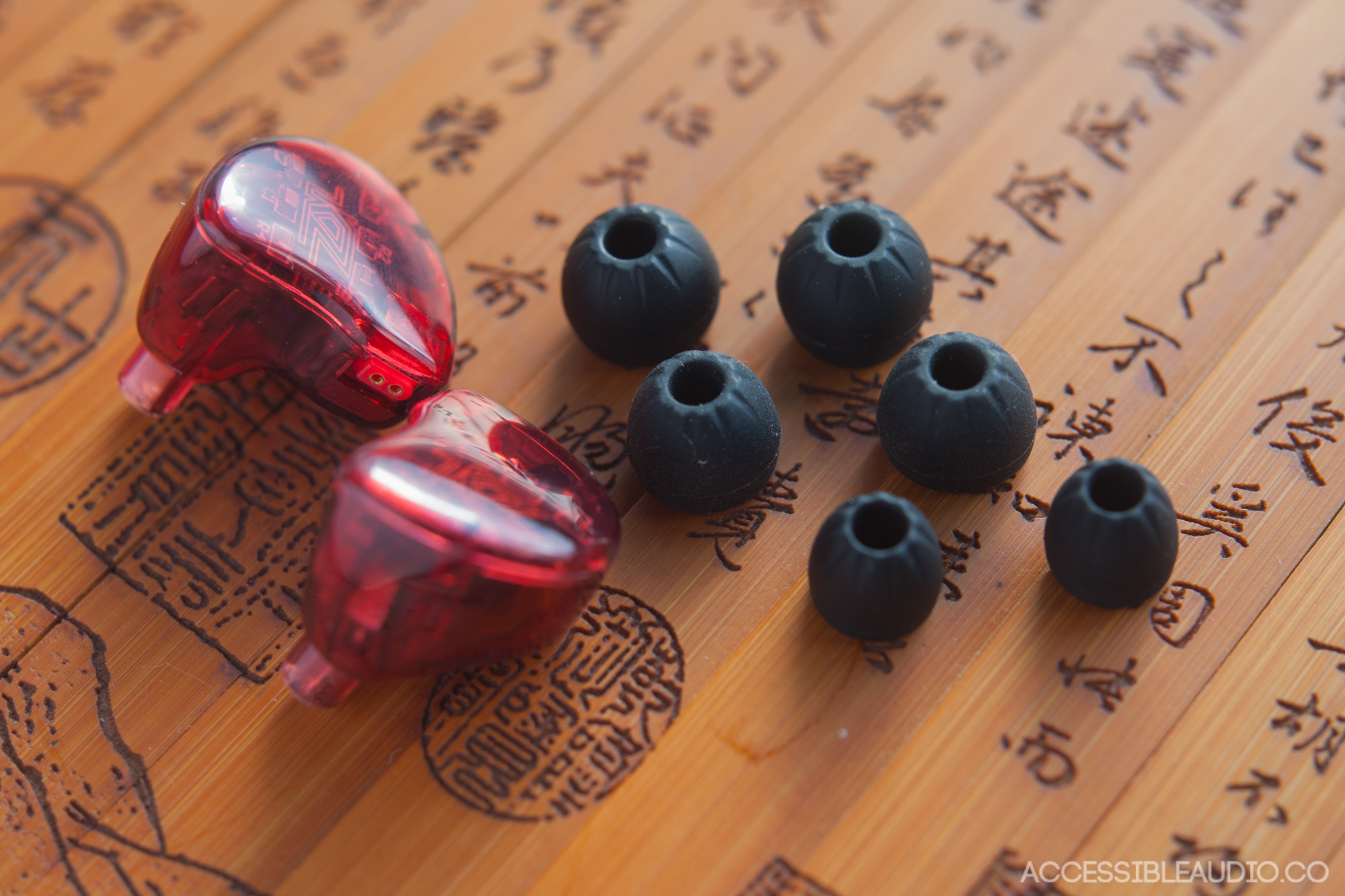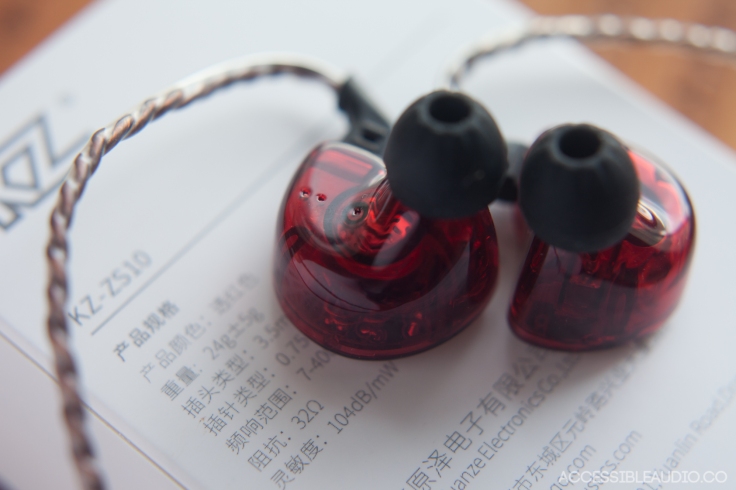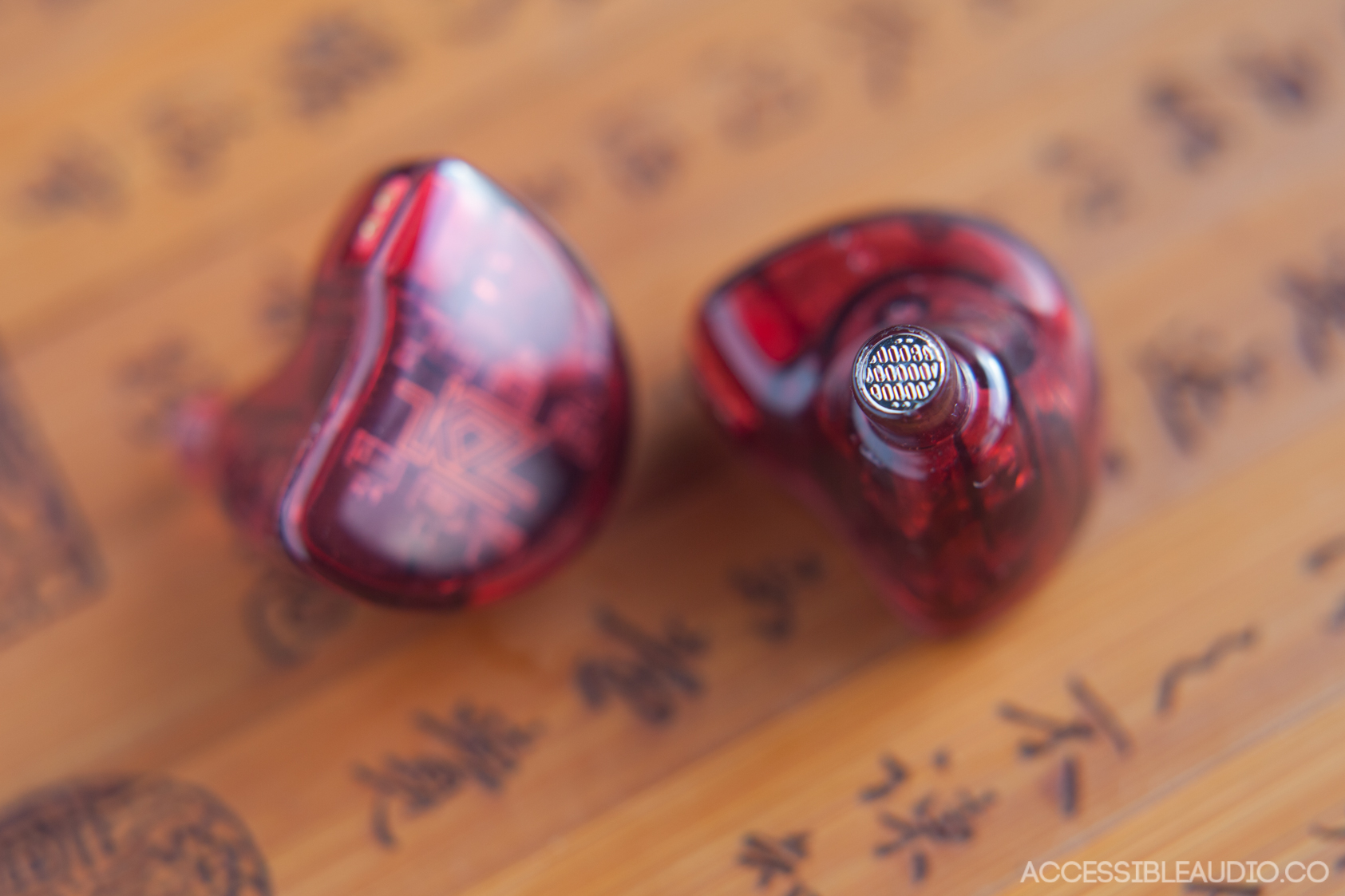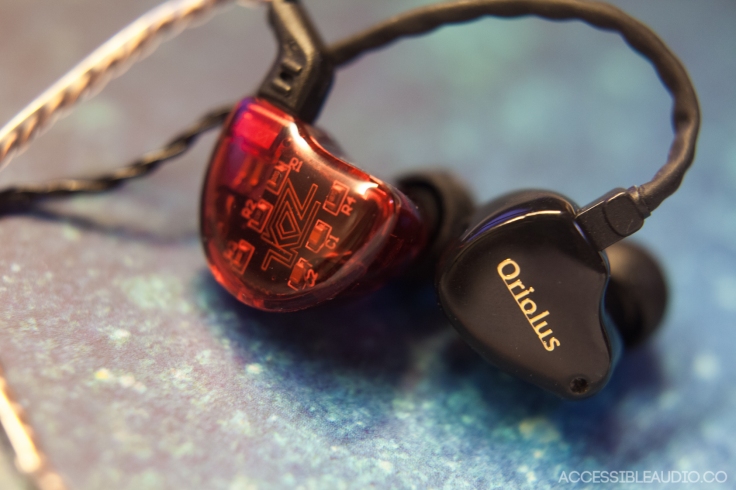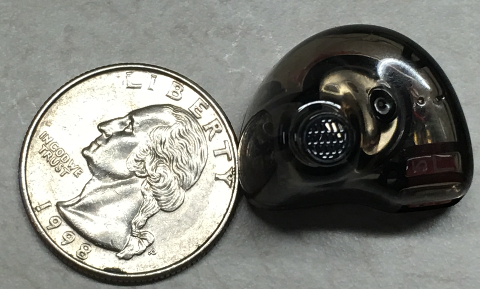Greetings,
Today we’re checking out what is currently Knowledge Zenith’s (KZ) flagship earphone, the ZS10.
The ZS10 is a five driver hybrid with four balanced armatures (BA) and one dynamic driver (DD), per side. It’s an earphone KZ has spent the last year or so developing. Two balanced armatures take on treble duty, two more cover the mids, and the dynamic addresses the low end. All of this is kept in line with a large crossover visible through the transparent shell. A crossover is something we haven’t seen in a KZ since the original ZS1 and the ZN1 with the inline amplifier and EQ module. The addition of a crossover is fitting as the ZS10 goes back to it’s roots, reviving the boisterous signature of the ZS1 while imbuing it with some additional technical competence. It also does away with the crazy, over boosted treble we have come to expect from this particular brand. The ZS10 is much more laid back than the ZST, ES3, ZS5, ZS6, ZSR, and recently released ED15, along with the most of the rest of their non-hybrid legacy lineup. Nope, it hearkens back to models like the ZS1, ED3c, HDS1, ATE, ATR, and DT5.

This laid back presentation signals a shift from the vast majority of KZ’s more recent releases, and is unlike the majority of like-priced Chinese earphones on the market which tend to be bright and bassy. On first listen the ZS10 lacks panache. It doesn’t have that in-your-face, over-the-top appeal of the ZSR, the Audbos/Magaosi K3, or the TFZ Exclusive 5. It is unlikely to pull you in right away and plant a goofy grin on your face. No, the ZS10 is more subtle than that. It drops a seed in the back of your mind. The more you listen to it, the more it grows and expands to reveal the nuances of what makes it so good. Of course this is dependent on your liking of this style of signature in the first place, or at the very least being open minded in trying new things. That is what makes KZ such an interesting brand for me and why I keep coming back; variety. That said, they have gotten quite samey as of late. The ZS10 is a welcome change, though one that not everyone will appreciate.

Let’s start the discussion on how they sound, beginning with what I feel is their least impressive aspect: bass. The ZS10 is on the bassy side, though not to the point it will please bassheads. The mid-range and treble regions being dialed back helps push forward the low frequencies. The ZS10’s low end is swole, but reasonably quick with a realistic decay, and yet a bit too smooth in texture. It counters these foibles with a hefty, thundering sub-bass presence and a soft but prominent mid-bass that dips off quickly as the mid-range BAs take over. There is some bloat that gives the impression of mid-bass bleeding into the the lower mids. Note that hooking them up to a good amp, like my TEAC HA-501 tightens up the low end considerably. With modern pop, EDM, and classic rock, admittedly the genres I listen to most, this style of tuning is very suitable and pretty much in line with where I would want it to be. Start shifting to other genres that require a more deft hand with greater precision, namely those that roll with less electronic influence, and the ZS10 starts to lose some of it’s appeal. While this style of bass is entertaining, it’s not particularly versatile or technically impressive. The newly released ED15 is much more successful in the nether regions to my ears, digging just as deep but with an improved mid-/sub-bass balance, more control, way more texture, and with a much more authoritative kick to it. That’s the dynamic driver they should have installed in the ZS10. The rest of the ED15 is pretty mediocre though, so that can stay where it is.
Leading into the ZS10’s mid-range sees improvements in my opinion. The middle and lower mid-range are recessed with a nice raise in the upper mids that gives vocalists who tend to sing in the upper registers more presence. The overall presentation is reasonably thick and robust with a fair bit of warmth to it, achieving a tonality and timbre that is much more natural than you’ll find on most other KZs, including the ZSR. This is shown in side-by-side comparisons, including those with the classic timbre-champ, JVC HA-FXT90 and significantly more expensive, modern earphones like the HiFiMan RE800 and RE2000. Detail and overall clarity is good, though not quite as impressive as you might want it to be for something with two balanced armatures working in tandem. Still, I find it a small step up from the ZSR. It’s not quite as impressive as the ZS6 though which is a detail monster. The presentation is smoother than both, playing into the warmth of the overall presentation. Overall I enjoy the ZS10’s mids and while I would like them to be more forward and carry more presence, I never found them being overshadowed or difficult to hear, especially at the lower volumes I listen and where the dynamic driver loses potency and prominence. They are also free of sibilance which is always a pleasure.
Speaking of being prominent, the ZS10’s treble isn’t. It is very laid back and mellow with decent extension and more airiness than would be expected from something so chill. Detail and clarity here is deceptively impressive. It’s not shoved in your face like it is on other products from KZ and competing brands like Kinera, Magaosi, and Brainwavz, among others. It’s a lot more like the TinAudio T1 in this regard, though with a touch less prominence and better extension. If you tend to listen to darker, less treble heavy products, it’s something you’ll be right at home with. Otherwise, give yourself some time to acclimatize. There is just enough emphasis across the board to give the ZS10 some mild sparkle and shimmer, keep the sound transparent, and limit opportunity for fatigue. Unless of course you listen at ridiculous volumes that risk damaging your hearing. At that point, yeah, they can get shrill and tiring, but that applies to pretty much everything at this price point.

What the ZS10 does better than most any sub-50 USD earphone I’ve heard is provide an engaging and immersive sound stage presentation. Just as with the ZS5, I don’t hear the ZS10 as having a massive, open stage and it falls behind the ZS6 and ZSR in overall size. It’s just above average to my ears with a little bit of extra added depth. No, what the ZS10 does especially well is combine the various layers of a piece of music, or the elements of a film’s auditory score, etc. and separate it beautifully. I’ve been using this earphone for media beyond music, namely film (catching up on Marvel films in anticipation of Infinity War), gaming (World of Tanks, Wipeout, and Dirt Rally, among others), and video commentary, for all of which it is outstanding. The ZS10 places you in the mix and surrounds you with sound.
While I think the ZS10 sounds pretty good, it also happens to be quite a large earphone. I suppose it would need to be given each side contains four balanced armatures, a fair-sized dynamic, and a large crossover board. KZ didn’t stuff those BA drivers in the nozzle as they’ve done on nearly every other hybrid they’ve released. This practice was never more evident than on the ZSR which ended up with monstrous 6mm nozzles in order to accommodate two BAs. With the ZS10, there are three separate sound chambers within the main housing, one for the dynamic, and two more for the mid-range and treble BAs, with all meeting up in the nozzle. The transparent housings show off this internal pipestry, including the construction of the crossover so you can visualize how everything is wired up inside. The overall build is good with very neat fit and finish, and the plastics feel just as dense and durable as those used by other brands like TFZ, Auglamour, Optoma Nuforce, among others.

Despite the size and that they tend to stick out a bit (read: a lot), I also found the ZS10 very comfortable, though that’s going to end up being a very personal thing. The nozzle is quite stubby so I went with tips that countered this; large Sony Hybrids, Spintfits from the CA Polaris, or basic foam tips you can get on AliExpress for under a buck a pop. Xiaomi’s huge triple flange tips from the Piston 2 also worked well. With the right tips and the memory wire bent into place, the ZS10 slipped into my ear without a fuss and never felt unstable. Isolation is pretty decent too, even with three fairly significant pin-hole vents along the inner portion of the housing. I never experienced any significant issues with external noise creeping in while using them out of the house, especially with foams in place.
The 2-pin receptors are the same as those found on every other recent KZ, meaning prior upgraded cables work just fine, both straight and L-shaped plug variants. I don’t really see the need to use them though because the ZS10 already comes with an upgraded cable, at least compared to the ones we’re used to. It’s braided and contains the same VSonic-style 90 degree angled jack and y-split found on the majority of their new products. This means that strain relief is merely okay, easily overshadowed by the excellent relief provided on KZs older products. Leading into the ear pieces you find some memory wire and L-shaped plugs. The memory wire used here is typical KZ; very good. You can set it to a shape and it will hold it, something you can’t say about the craptacular memory wire more established brands set upon their premium earphones. The cable itself is very flexible, doesn’t retain memory of bends or kinks, and transmits little noise when rubbing against things. The only aspect of it I dislike is that above the y-split it is on the thin side and tangles easily. It untangles just as easily though so it’s never more than a minor annoyance, for me at least. Oh, and no chin cinch. KZ really needs to start including those. Overall a great cable upgrade, one we should hope KZ includes as standard on everything from here on in. They did with the ED15, so there’s hope.

Packaging is typical modern KZ with the ZS10 arriving in a compact white box. The front of the outer sheath contains a colored image of the ZS10 and a brief product description while the rear contains the specifications and contact information for KZ. Sliding off the sheath shows off the ZS10’s bulky earpieces set loosely within a plastic tray. Underneath the tray is an instruction manual, spare ear tips, and the cable. The included tips are KZs community named “Starline” model with small ridges around the bore, provided in small, medium, and large sizes. I personally am a huge fan of these tips because they rarely alter sound quality, are made of a dense yet flexible rubber, provide a reliable seal, and if buying them separately, are hilariously inexpensive given the quality. They’re awesome and for me easily rank up there with the best tips from Final Audio, JVC, and Sony. Feel free to think otherwise, cause I ain’t agreeing with you.
Oh, and because there will undoubtedly be questions about it, how does the ZS10 fare against the TinAudio T2. Is it better? No. They’re both great in their own ways. The T2 is much more neutral and balanced with a brighter, more lively sound, and a similar sound stage. The ZS10 bests it in terms of layering and separation, giving off a greater sense of depth and dynamic-ism to my music. All accomplished while having a laid back presentation more in line with the T1. How does it fare against the ZSR, the KZ I said was their most accomplished hybrid to date? It’s smoother, just as detailed, but isn’t as bright, nor as bassy. ZSR has a more capacious stage but lacks the ZS10’s imaging and layering capabilities. After listening to the two back-to-back, it takes some time to get back into the ZSR’s more edgy, vibrant, forward signature. How about against the Brainwavz B400’s quad-BA setup? No comparison. The B400 has a near-neutral signature with more detail, tighter bass with more punch to it, more treble energy, and exceeds the ZS10 in terms of staging qualities like separation and imaging accuracy. The B400 is much more delicate though with it’s 3D printed housings, and doesn’t feel as robust or durable as the ZS10. What happens if you pit it against my 100 USD benchmark, the MacaW GT600s? Well, it certainly can’t complete in terms of build, packaging, accessories, or features, but it does sound at least as good, if not a little better. As with most of the aforementioned earphones, the ZS10 takes the cake in imaging accuracy, layering, and separation. The ZS10 loses out in balance with it’s bassier signature but is more detailed. Just as I felt about the ZS5, ZS6, and ZSR, the ZS10 competes with 100 USD earphones, just not the best of that bunch.

The ZS10 is exactly what Knowledge Zenith should have delivered as their new flagship. It is visually impressive with the see through shell letting you glimpse at the drivers and crossover. It has a reasonably versatile signature that pairs exceptionally well with modern pop and electronic music. It also happens to show off some killer imaging, layering and separation qualities, all wrapped within a warm, non-fatiguing sound.
Comfort will be a hit or miss given the massive shells but you can counter that with average to large outer ears and the right tips. Although, I suppose not everyone can change their ear size at will, nor does everyone have a large collection of tips to cycle through. At least the included tips are pure quality and should work well enough for most. The warm signature won’t be for everyone either, but that’s okay. Variety in tuning is a good thing, and you have other great options in the price range like the neutral TinAudio T2, or the mid-focused Kinera SEED, or maybe the vibrant and audacious Audbus DB-02.

The best thing of all? KZ managed to create and release a five driver hybrid with good looks, build quality, and an engaging sound, all for under 50 USD. Of course you can argue that others do better with just one dynamic, but this is the culmination of years of expensive tech trickling down to affordable prices. Products like the ZS10 are going to continue to force the competition to step up, something which greatly benefits us, their customers. To me, the ZS10 is a worthy purchase and easily validates it’s current flagship status in KZ’s expansive lineup of products.
Thanks for reading!
– B9Scrambler
Disclaimer: A big thanks to Lillian with DD-Audio for sending over a sample of the ZS10 for me to review. The thoughts within this review are my own and do not represent DD-Audio, Knowledge Zenith, or any other entity. There was no financial incentive provided either. Here are some links to DD-Audio’s stores (no affiliate links…I don’t participate in those programs):
AliExpress:
https://www.aliexpress.com/store/pr...-Monitor-IEMs-Sports/2894006_32858656236.html
Amazon:
https://www.amazon.com/dp/B07BVKXYBB/ref=sr_1_5?ie=UTF8&sr=8-5&keywords=kz+zs10
For those that dislike reviewers covering samples, know I separately ordered and paid for another ZS10 using my own hard-earned Canadian dollars during the initial pre-order release period. Cheers!
Sources: For at home use the ZS10 was powered by my TEAC HA-501 desktop headphone amp. For portable use it was paired with the Auglamour GR-1 or Walnut F1 paired with my Shanling M1, LG G5, or HiFi E.T. MA8. The ZS10 is easy to drive and does benefit slightly from some extra juice, seeing improvements in bass quality, though this is far from necessary and not something that is worth buying a separate amp for.
Specifications: Impedance: 22 ohm / Sensitivity: 107dB +/- 3dB / Frequency Response: 10hz – 30khz
Some Test Material: Aesop Rock – Skelethon (Album) / Daft Punk – Random Access Memories (Album) / Elton John – Yellow Golden Brick Road (Album) / King Crimson – Lark’s Tongues in Aspic (Album) / King Crimson – Starless and Bible Black (Track) / Supertramp – Crime of the Century (Album) / Infected Mushroom – Converting Vegetarians (Album) / Infected Mushroom – Legend of the Black Shawarma (Album) / Gorillaz – Plastic Beach (Album) / Massive Attack – Mezzanine (Album) / Fleetwood Mac – Rumors (Album) / Run the Jewels – Run the Jewels (Album) / The Prodigy – The Day is My Enemy (Album) / Tobacco – screw*d Up Friends (Album) / Felt – Felt 2 (A Tribute to Lisa Bone) (Album)

























 Something calm at 50 USD would be a Shozy HIBIKI, which has a smooth treble, but ZS10 is fairly sparkly and energetic. This is not a downside, I like sparkly treble. I will continue looking into new ZS IEMs and will provide more info on those as well
Something calm at 50 USD would be a Shozy HIBIKI, which has a smooth treble, but ZS10 is fairly sparkly and energetic. This is not a downside, I like sparkly treble. I will continue looking into new ZS IEMs and will provide more info on those as well


